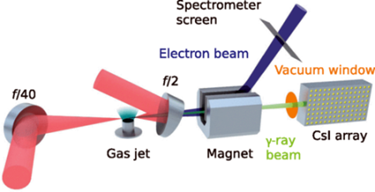High-Power Laser Throws Light On Radiation Reaction

Scientists report radiation reaction when an electron beam travelling close to the speed of light collides with a high-intensity laser
Electromagnetic radiation is all around us. It’s in the radio waves that make mobile phones work, in the rainbow we see when it rains on a sunny day, and in the invisible infrared waves we use in our remote controls to change TV channels. We know it comes in many forms, from radio waves and microwaves all the way up to the high-energy X-rays and gamma rays. But what, precisely, is it?
Electromagnetic radiation is the energy a charged particle, such as an electron, emits when it accelerates. When the accelerating particle releases this energy, it experiences a recoil force called a ‘radiation reaction’. Normally, radiation reaction forces are too small to consider, but they do become significant in laser-plasma interactions and astrophysical contexts, where high-electromagnetic fields and high-electron energies come into play.
A paper published in the journal ‘Physical Review X’ presents evidence of a radiation reaction occurring when a high-intensity laser pulse collides with a high-energy electron beam. A team of scientists supported by the EU-funded TeX-MEx and SF-QFT projects conducted this experiment using the Astra Gemini laser belonging to the Central Laser Facility in the United Kingdom.
The dual-beam Astra Gemini laser generates two synchronised laser beams, which together deliver a quadrillion (10¹⁵) watts of power. In the experiment, one laser pulse was used to produce a bunch of high-energy electrons through a process known as laser-wakefield acceleration, while the second laser was directed at the electron bunch. When the electron beam and laser pulse collided, the electrons oscillated in the second laser’s electromagnetic field and scattered the laser beam’s photons, which were detected as gamma rays. The electrons’ energy loss also resulted in a radiation reaction.
The difficulty of achieving a collision may be better appreciated if we consider the fact that laser pulses are thinner than a human hair and, with each lasting 45 quadrillionths of a second, had to hit what one of the scientists described as “micron-sized electron bullets” travelling at near-light speed. A collision was thought to be successful when high-energy gamma radiation was detected. Taking these infinitesimal speeds and widths into account, together with added factors such as electron beam variations from shot to shot and laser pointing and timing, it’s quite clear why only a small number of collisions were successful.
The measurements obtained were used to compare quantum and classical models of radiation reaction. It was found that classical models tended to overestimate radiation reaction forces and gamma ray energies compared to quantum models. It was also concluded that the data was more consistent with a quantum electromagnetic model, but the fact remained that this only occurred slightly over 68 % of the time and further studies were needed to properly assess different models.
Looking to the future
The project team’s main challenge going forward is to combine high-laser intensities, beam stability and high beam energies simultaneously in future experiments in order to gather enough data for a systematic study of quantum radiation reaction.
Using laser-plasma technology, the TeX-MEx (Time resolved X-ray probing of Matter under Extreme conditions) project aims to increase knowledge about how matter behaves throughout the universe. The SF-QFT (Fundamental physics with intense laser fields) project is tasked with testing relativistic and quantum effects in intense laser fields to gain new insights and provide support for future high-intensity laser experiments in the EU.
Source: European Commission
